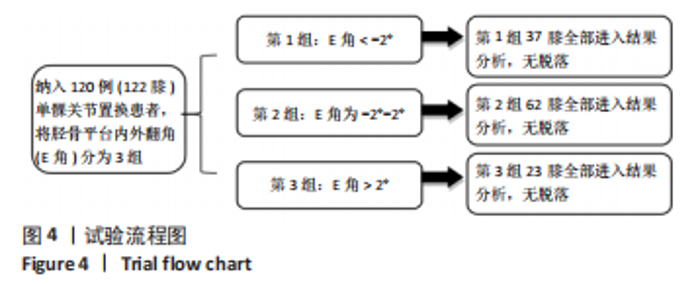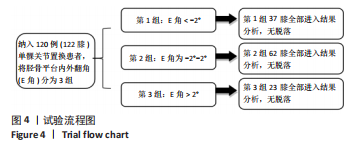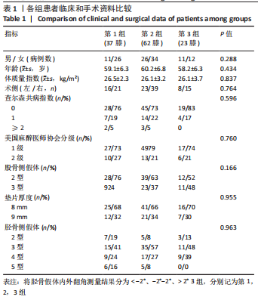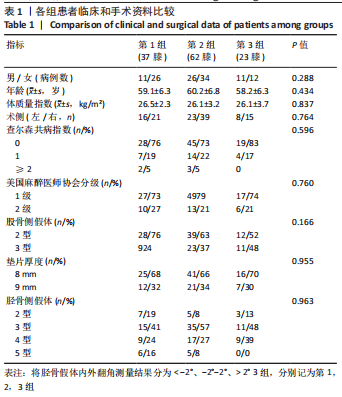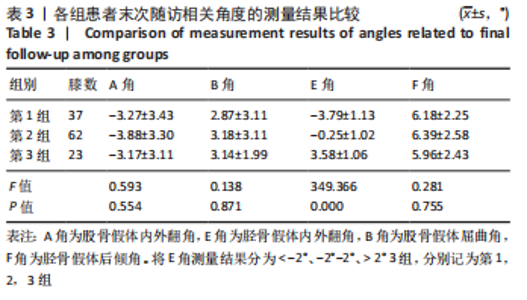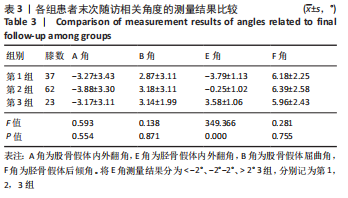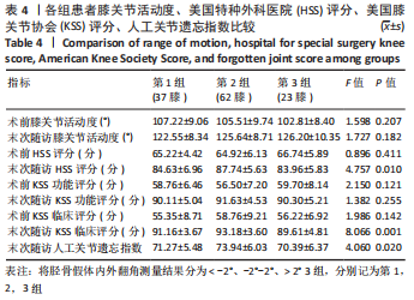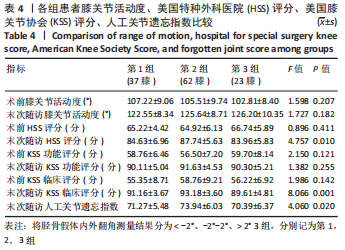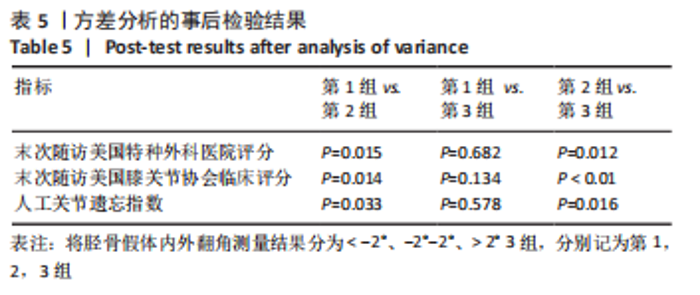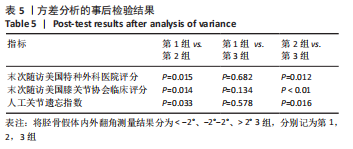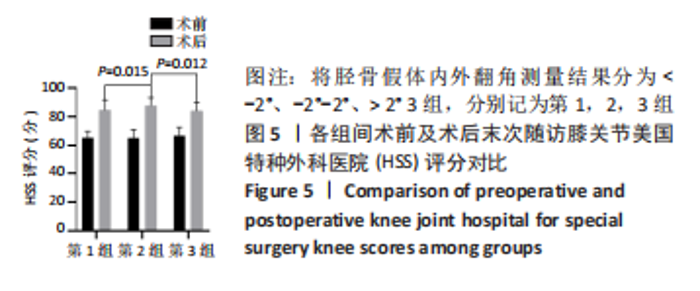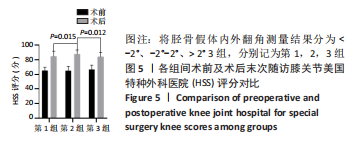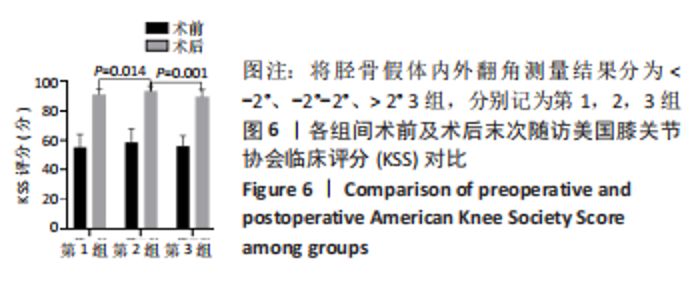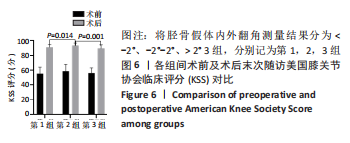Chinese Journal of Tissue Engineering Research ›› 2024, Vol. 28 ›› Issue (24): 3827-3832.doi: 10.12307/2024.090
Previous Articles Next Articles
Effect of varus and valgus angles of tibial prosthesis on short-term outcome of fixed bearing unicompartmental knee arthroplasty
Wang Hu, Feng Shuo, Zhang Qiang, Chen Jiahao, Chen Xiangyang
- Department of Orthopedic Surgery, Affiliated Hospital of Xuzhou Medical University, Xuzhou 221000, Jiangsu Province, China
-
Received:2023-04-20Accepted:2023-06-19Online:2024-08-28Published:2023-11-20 -
Contact:Chen Xiangyang, MD, Chief physician, Associate professor, Department of Orthopedic Surgery, Affiliated Hospital of Xuzhou Medical University, Xuzhou 221000, Jiangsu Province, China -
About author:Wang Hu, Master candidate, Department of Orthopedic Surgery, Affiliated Hospital of Xuzhou Medical University, Xuzhou 221000, Jiangsu Province, China -
Supported by:Scientific Research Project of Elderly Health of Jiangsu Province, No. LX2021010 (to CXY)
CLC Number:
Cite this article
Wang Hu, Feng Shuo, Zhang Qiang, Chen Jiahao, Chen Xiangyang. Effect of varus and valgus angles of tibial prosthesis on short-term outcome of fixed bearing unicompartmental knee arthroplasty[J]. Chinese Journal of Tissue Engineering Research, 2024, 28(24): 3827-3832.
share this article
Add to citation manager EndNote|Reference Manager|ProCite|BibTeX|RefWorks
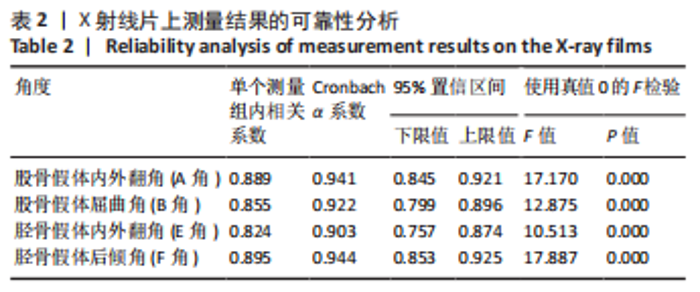
2.4 X射线片角度测量的可靠性分析 由2名医师独立使用徐州医科大学附属医院影像归档和通讯系统进行测量并记录A角、B角、E角和F角数值,由此每个角度均可获得2个测量值。采用Two-way random effects model可靠性分析,取组内相关系数95%的可信区间。评价一致性采用平均度量组内相关系数即Cronbach α,若Cronbach α≥0.80 为强,0.60≤Cronbach α < 0.80 为中等,0.30≤Cronbach α < 0.60 为可,Cronbach α < 0.3 为弱,详见表2。可见4个角度的Cronbach α值均大于0.90,说明2名医生对这4个角度的测量结果具有很高的一致性。"
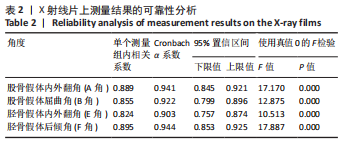
| [1] 中华医学会骨科学分会关节外科学组, 中国医师协会骨科医师分会骨关节炎学组, 国家老年疾病临床医学研究中心(湘雅医院),等. 中国骨关节炎诊疗指南(2021年版)[J]. 中华骨科杂志,2021,41(18):1291-314. [2] JENNINGS JM, KLEEMAN-FORSTHUBER LT, BOLOGNESI MP. Medial Unicompartmental Arthroplasty of the Knee. J Am Acad Orthop Surg. 2019;27(5):166-176. [3] HAUER G, SADOGHI P, BERNHARDT GA, et al. Greater activity, better range of motion and higher quality of life following unicompartmental knee arthroplasty: a comparative case-control study. Arch Orthop Trauma Surg. 2020;140(2):231-237. [4] WILSON HA, MIDDLETON R, ABRAM SGF, et al. Patient relevant outcomes of unicompartmental versus total knee replacement: systematic review and meta-analysis. Bmj. 2019;364:1352. [5] AL-DADAH O, HAWES G, CHAPMAN-SHEATH PJ, et al. Unicompartmental vs. segmental bicompartmental vs. total knee replacement: comparison of clinical outcomes. Knee Surg Relat Res. 2020;32(1):47. [6] FRIESENBICHLER B, ITEM-GLATTHORN JF, WELLAUER V, et al. Short-term functional advantages after medial unicompartmental versus total knee arthroplasty. Knee. 2018;25(4):638-643. [7] ARGENSON JN, KOMISTEK RD, AUBANIAC JM, et al. In vivo determination of knee kinematics for subjects implanted with a unicompartmental arthroplasty. J Arthroplasty. 2002;17(8):1049-1054. [8] NEUFELD ME, ALBERS A, GREIDANUS NV, et al. A Comparison of Mobile and Fixed-Bearing Unicompartmental Knee Arthroplasty at a Minimum 10-Year Follow-up. J Arthroplasty. 2018,33(6):1713-1718. [9] 万伏银, 郭万首. 单髁假体的演变及现状 [J]. 中国组织工程研究,2017, 21(23):3753-3759. [10] KUROSAWA H, FUKUBAYASHI T, NAKAJIMA H. Load-bearing mode of the knee joint: physical behavior of the knee joint with or without menisci. Clin Orthop Relat Res. 1980;(149):283-290. [11] FUKUBAYASHI T, KUROSAWA H. The contact area and pressure distribution pattern of the knee. A study of normal and osteoarthrotic knee joints. Acta Orthop Scand. 1980;51(6):871-879. [12] CARTIER P, SANOUILLER JL, GRELSAMER RP. Unicompartmental knee arthroplasty surgery. 10-year minimum follow-up period. J Arthroplasty. 1996;11(7):782-788. [13] KWON OR, KANG KT, SON J, et al. Importance of joint line preservation in unicompartmental knee arthroplasty: Finite element analysis. J Orthop Res. 2017;35(2):347-352. [14] ZHU GD, GUO WS, ZHANG QD, et al. Finite Element Analysis of Mobile-bearing Unicompartmental Knee Arthroplasty: The Influence of Tibial Component Coronal Alignment. Chin Med J (Engl). 2015;128(21):2873-2878. [15] EDMONDSON MC, ISAAC D, WIJERATNA M, et al. Oxford unicompartmental knee arthroplasty: medial pain and functional outcome in the medium term. J Orthop Surg Res. 2011;6:52. [16] 卢文龙. 单髁关节置换活动平台与固定平台的早期临床对照研究[D]. 郑州: 郑州大学,2018. [17] 王卫刚, 杨植栋, 冯宗权, 等. 膝关节固定平台单髁假体置换的中期随访评价[J]. 中国组织工程研究,2021,25(3):368-373. [18] BARRETT MC, WILKINSON FO, BLOM AW, et al. Incidence, temporal trends and potential risk factors for aseptic loosening following primary unicompartmental knee arthroplasty: A meta-analysis of 96,294 knees. Knee. 2021;31:28-38. [19] EPINETTE JA, BRUNSCHWEILER B, MERTL P, et al. Unicompartmental knee arthroplasty modes of failure: wear is not the main reason for failure: a multicentre study of 418 failed knees. Orthop Traumatol Surg Res. 2012; 98(6 Suppl):S124-S130. [20] SASATANI K, MAJIMA T, MURASE K, et al. Three-Dimensional Finite Analysis of the Optimal Alignment of the Tibial Implant in Unicompartmental Knee Arthroplasty. J Nippon Med Sch. 2020;87(2):60-65. [21] KANG KT, PARK JH, KOH YG, et al. Biomechanical effects of posterior tibial slope on unicompartmental knee arthroplasty using finite element analysis. Biomed Mater Eng. 2019;30(2):133-144. [22] KANG KT, KIM SH, SON J, et al. Validation of a computational knee joint model using an alignment method for the knee laxity test and computed tomography. Biomed Mater Eng. 2017;28(4):417-429. [23] PAUL JP. Simulation of a knee joint replacement during a gait cycle using explicit finite element analysis. J Biomech. 2005;38(3):635. [24] INNOCENTI B, PIANIGIANI S, RAMUNDO G, et al. Biomechanical Effects of Different Varus and Valgus Alignments in Medial Unicompartmental Knee Arthroplasty. J Arthroplasty. 2016;31(12):2685-2691. [25] SLAVEN SE, CODY JP, SERSHON RA, et al. Alignment in Medial Fixed-Bearing Unicompartmental Knee Arthroplasty: The Limb Has a Leg Up on the Component. J Arthroplasty. 2021;36(12):3883-3887. [26] KANG KT, SON J, KWON SK, et al. Preservation of femoral and tibial coronal alignment to improve biomechanical effects of medial unicompartment knee arthroplasty: Computational study. Biomed Mater Eng. 2018;29(5):651-664. [27] HEYSE TJ, EL-ZAYAT BF, DE CORTE R, et al. Balancing UKA: overstuffing leads to high medial collateral ligament strains. Knee Surg Sports Traumatol Arthrosc. 2016;24(10):3218-3228. [28] GULATI A, CHAU R, SIMPSON DJ, et al. Influence of component alignment on outcome for unicompartmental knee replacement. Knee. 2009;16(3):196-199. [29] CHATELLARD R, SAULEAU V, COLMAR M, et al. Medial unicompartmental knee arthroplasty: does tibial component position influence clinical outcomes and arthroplasty survival? Orthop Traumatol Surg Res. 2013; 99(4 Suppl):S219-S225. [30] IESAKA K, TSUMURA H, SONODA H, et al. The effects of tibial component inclination on bone stress after unicompartmental knee arthroplasty. J Biomech. 2002;35(7):969-974. [31] SAWATARI T, TSUMURA H, IESAKA K, et al. Three-dimensional finite element analysis of unicompartmental knee arthroplasty--the influence of tibial component inclination. J Orthop Res. 2005;23(3):549-554. [32] ESCUDIER JC, JACQUET C, FLECHER X, et al. Better Implant Positioning and Clinical Outcomes With a Morphometric Unicompartmental Knee Arthroplasty. Results of a Retrospective, Matched-Controlled Study. J Arthroplasty. 2019;34(12):2903-2908. [33] SLAVEN SE, CODY JP, SERSHON RA, et al. The Impact of Coronal Alignment on Revision in Medial Fixed-Bearing Unicompartmental Knee Arthroplasty. J Arthroplasty. 2020;35(2):353-357. [34] PERLICK L, BÄTHIS H, TINGART M, et al. Minimally invasive unicompartmental knee replacement with a nonimage-based navigation system. Int Orthop. 2004;28(4):193-197. [35] ROSENBERGER RE, FINK C, QUIRBACH S, et al. The immediate effect of navigation on implant accuracy in primary mini-invasive unicompartmental knee arthroplasty. Knee Surg Sports Traumatol Arthrosc. 2008;16(12): 1133-1140. [36] FITZPATRICK C, FITZPATRICK D, LEE J, et al. Statistical design of unicompartmental tibial implants and comparison with current devices. Knee. 2007;14(2):138-144. |
| [1] | Zhang Kai, Zhao Mingxin, Yang Yuzhu, Guo Yuan, Ji Binping. Effect of tibial prosthesis riser length on knee biomechanics after unicompartmental knee arthroplasty [J]. Chinese Journal of Tissue Engineering Research, 2024, 28(21): 3281-3285. |
| [2] | Gu Xu, Zheng Xin, Shi Sifeng, Lu Renxiang, Cao Jie, Li Hongwei. Stability of early gait after unicompartmental knee arthroplasty [J]. Chinese Journal of Tissue Engineering Research, 2024, 28(12): 1875-1879. |
| [3] | Zhu Xunpeng, Xu Hui, Wang Lin, Wang Jun, Zhang Hui. Relationship of preoperative sleep quality and early rehabilitation after unicompartmental knee arthroplasty [J]. Chinese Journal of Tissue Engineering Research, 2023, 27(36): 5806-5811. |
| [4] | Li Haoran, Huang Jian. Application of finite element analysis in artificial knee arthroplasty [J]. Chinese Journal of Tissue Engineering Research, 2023, 27(31): 5058-5063. |
| [5] | Shi Sifeng, Lin Qiang, Zhou Bing, Chen Xiangyang, Lu Wenhai. Comparison of cementless and cemented femoral prosthesis for unicompartmental knee arthroplasty in the treatment of osteoarthritis [J]. Chinese Journal of Tissue Engineering Research, 2023, 27(18): 2848-2853. |
| [6] | Hu Zhenghao, Chen Wang, Feng Shuo, Zhang Leshu, Chen Xiangyang. Significance of changes in posterior tibial slope plateau after unicompartmental knee arthroplasty [J]. Chinese Journal of Tissue Engineering Research, 2023, 27(18): 2854-2860. |
| [7] | Liu Shaohua, Zhou Guanming, Chen Xicong, Xiao Keming, Cai Jian, Liu Xiaofang. Changes in kinematic parameters after unicompartmental knee arthroplasty and high tibial osteotomy [J]. Chinese Journal of Tissue Engineering Research, 2022, 26(3): 390-396. |
| [8] | Tang Jixiang, Jing Lin, Zhang Hongmei, Yan Qi, Pan Li. Early and midterm effects of lower limb force line correction after mobile-bearing unicompartmental knee arthroplasty [J]. Chinese Journal of Tissue Engineering Research, 2022, 26(18): 2834-2838. |
| [9] | Ma Pengcheng, Zhang Siping, Sun Rongxin, Chai Hao, Jiang Kan. Biomechanical effects of different placement of femoral prosthesis in unicompartmental knee arthroplasty [J]. Chinese Journal of Tissue Engineering Research, 2022, 26(12): 1843-1848. |
| [10] | Zhao Zhongyi, Li Yongzhen, Chen Feng, Ji Aiyu. Comparison of total knee arthroplasty and unicompartmental knee arthroplasty in treatment of traumatic osteoarthritis [J]. Chinese Journal of Tissue Engineering Research, 2021, 25(6): 854-859. |
| [11] | Liu Shaohua, Zhou Guanming, Chen Xicong, Xiao Keming, Cai Jian, Liu Xiaofang. Influence of anterior cruciate ligament defect on the mid-term outcome of fixed-bearing unicompartmental knee arthroplasty [J]. Chinese Journal of Tissue Engineering Research, 2021, 25(6): 860-865. |
| [12] | Qiao Renqiu, Yin Li, Zhang Yi, Wang Haitao, Xia Peige, Kong Zhiheng. Medium- and long-term assessment of lateral compartment and patellofemoral compartment osteoarthritis after medial unicompartmental knee arthroplasty with Oxford mobile-bearing [J]. Chinese Journal of Tissue Engineering Research, 2021, 25(33): 5318-5323. |
| [13] | Lin Xiaodong, Liu Wengang, Xu Xuemeng, Liu Xin, Lu Chao, Song Min, Li Congcong. Unicompartmental knee arthroplasty superior to open-wedge high tibial osteotomy: differences of mechanical parameters and knee function [J]. Chinese Journal of Tissue Engineering Research, 2021, 25(30): 4793-4798. |
| [14] | Wang Dasai, Zhang Yang, Cheng Yin, Wang Qiang. Efficacy and safety of staged versus simultaneous unicompartmental knee arthroplasty: a meta-analysis#br# [J]. Chinese Journal of Tissue Engineering Research, 2021, 25(24): 3929-3936. |
| [15] | Yu Yinghao, Zhao Jijun, Liu Dongcheng, Chen Yuhao, Feng Dehong. Clinical significance of preoperative planning assisted unicompartmental knee arthroplasty with digital imaging system for fixed-bearing prosthesis [J]. Chinese Journal of Tissue Engineering Research, 2021, 25(21): 3324-3331. |
| Viewed | ||||||
|
Full text |
|
|||||
|
Abstract |
|
|||||
